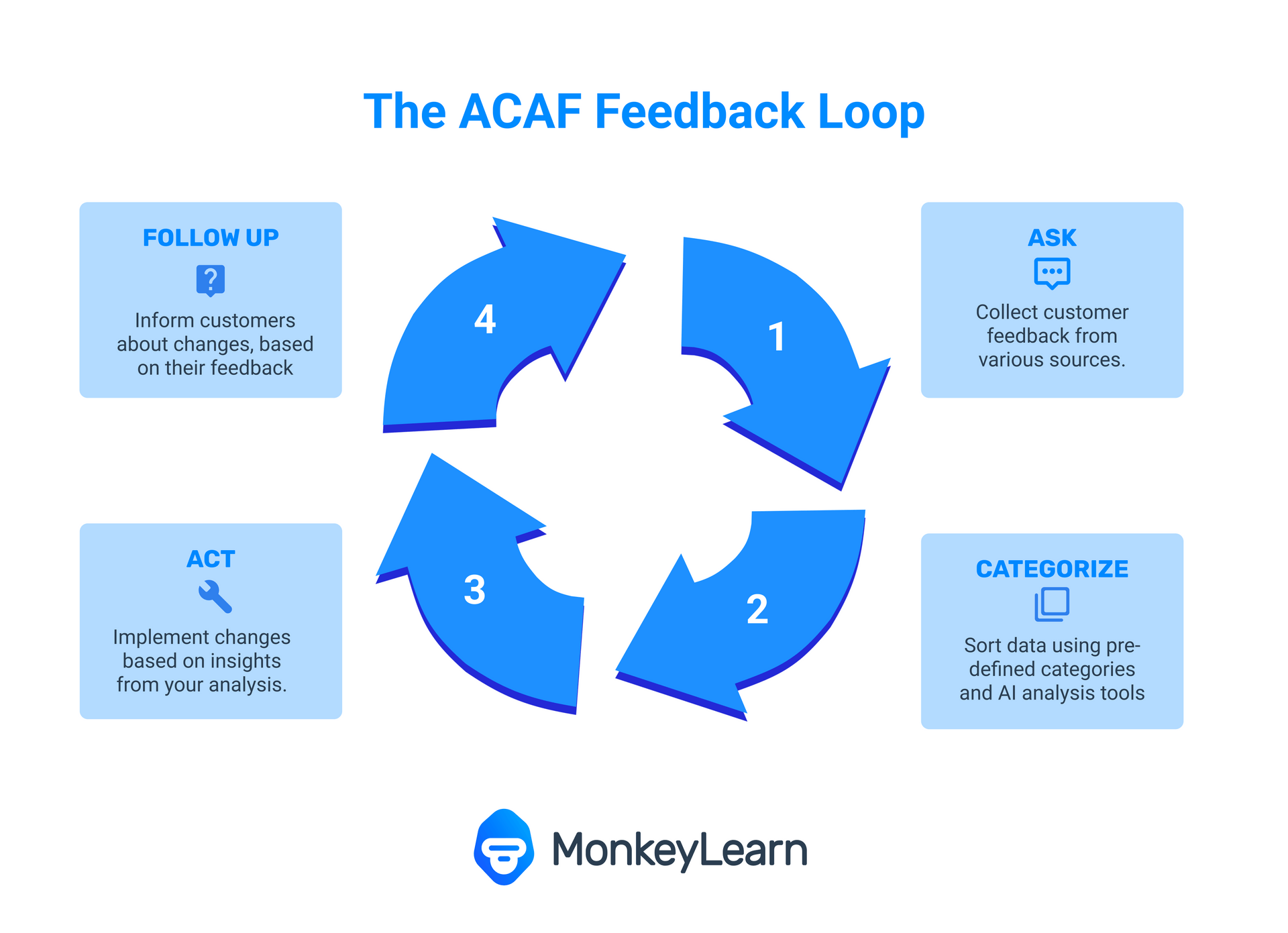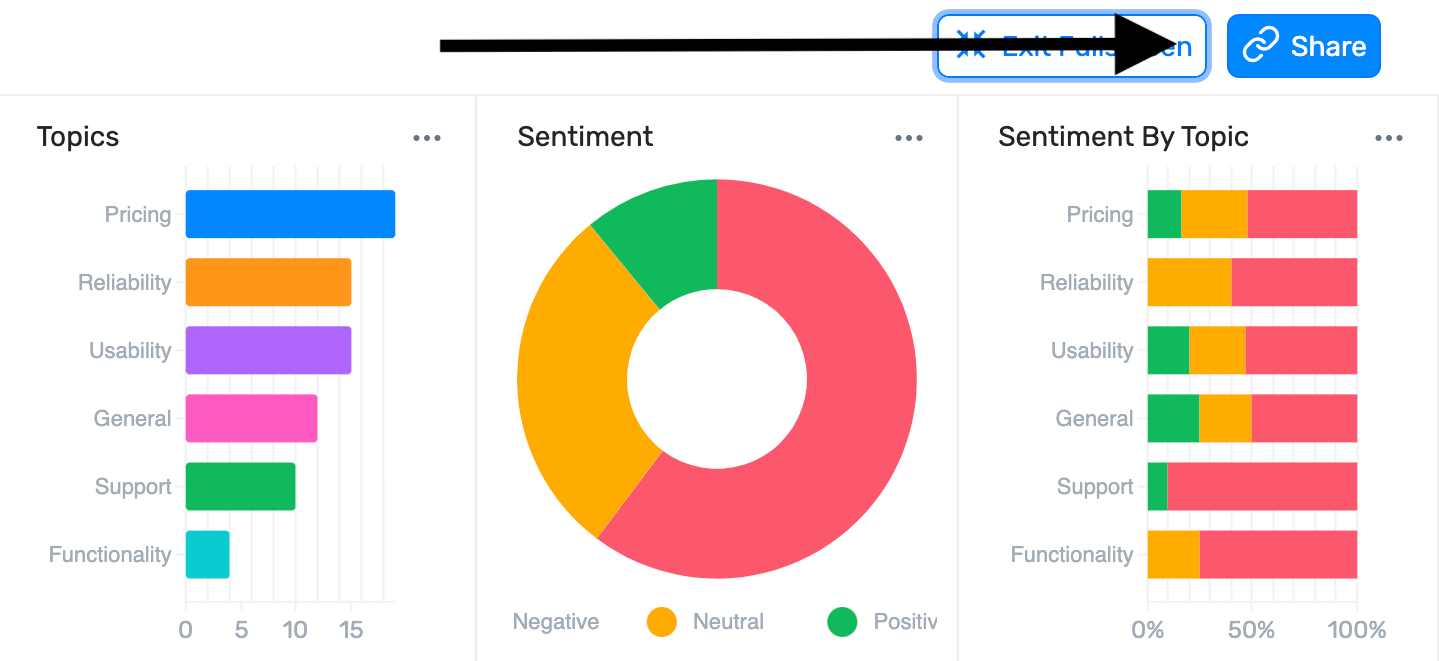A Customer Feedback System for Business Success

“The path to digital transformation is a feedback loop.” – Sashi Sreedharan, Managing Director, Microsoft India.
Without a feedback loop, you’ll struggle to keep customers happy.
And happy customers are, of course, the cornerstone of any successful business.
To create a customer feedback loop, you’ll need to keep tabs on customer satisfaction by regularly asking for customer feedback, categorizing, acting, and following up on it.
But to make sure your loop is successful, you’ll need the right tools to manage it.
“At the heart of this loop is data and AI”, explains Sashi.
When combining data and AI, businesses can engage with their customers, transform products, optimize operations and empower employees in a much more powerful way.
So, setting up a customer feedback system that involves analyzing your data with AI should be the first step on your digital transformation journey.
If you don’t take the time to properly understand your customers then you won’t understand why your business is growing or shrinking.
Why Collect Customer Feedback?
It’s simple. Without customer feedback, you’ll struggle to know what your customers need from your products or services.
And that means you’ll fail to keep customers satisfied. As a result you’ll see an increase in customers switching to the competition.
Need proof?
50% of customers will switch to a competitor after one bad experience. If you don’t keep tabs on what those bad experiences are by gathering and listening to customer feedback, your churn rate will continue to rise.
Customers no longer base their loyalty on price or product. There’s a strong relationship between customers remaining loyal to a company and great customer experiences. But to deliver the best customer experience, you’ll need to gather customer feedback so you know exactly what your customers need and expect.
Your strategy for collecting customer feedback should be broad but also targeted.
That means collecting all your customer feedback, regardless of where it’s coming from (online reviews, forums, social media), but also collecting feedback that targets specific customers (via surveys, email).
For customer support, especially, you’ll want to adopt multi-channel support to receive customer feedback.
Reports show that those that do adopt multi-channel support are likely to perform better than those that don’t because customers want to be able to connect with brands in the way that’s most convenient to them.
By sending customer surveys (like CSAT, NPS, and CES) that ask questions about specific products, features, touchpoints, and more, you can really drill down on which aspects you need to improve.
Creating a robust customer feedback system can help you streamline how you generate, collect, and analyze what customers are saying about your business or product.
Also, known as a customer feedback loop, we’ll show you how to create a strategy that works for you.
The Customer Feedback Loop: Ask, Categorize, Act, Follow Up (ACAF)

A customer feedback system is a framework of tools and techniques for obtaining insights from feedback from multiple sources and platforms to improve the customer experience (CX).
An efficient and properly managed customer feedback system can automate how you ask for and analyze customer feedback, wherever it may be, for real-time, customer-led insights.
Business will then use those insights to inform business decisions that put customers at the top.
Let’s take a closer look at how you can create a successful customer feedback system by going over each step of the ACAF feedback loop:
- 1. Ask: gather customer feedback
- 2. Categorize: analyze customer feedback with AI
- 3. Act: improve products and services
- 4. Follow Up: inform customers and ask for feedback
1. Ask
This is the first stage of the customer feedback loop and involves collecting customer feedback.
There are two ways to gather customer feedback: you can collect unsolicited feedback, things like online reviews, social media comments, customer support requests, or you can ask for customer feedback (solicited customer feedback) via customer satisfaction surveys.
Surveys are a great way to collect targeted feedback about your products, services, and overall experience with your business.
Here are the most popular surveys that businesses use to collect both quantitative customer feedback (close-ended question) and qualitative customer feedback (the follow up, open-ended question):
- CSAT surveys are used to collect feedback at every stage of the customer journey
- NPS surveys are generally send once every quarter to gauge customer loyalty toward a brand
- CES surveys aim to measure how much effort it takes for a customer to use your product or solve an issue with your customer support.
- PMF surveys ask customers how they would feel if they could no longer use a product to gauge the success of a product.
Unsolicited feedback often offers more details that you’re unlikely to get from surveys or requested feedback. This type of customer feedback leads to more honest opinions about how customers perceive your business and may also reveal something new.
For example, customer reviews from sites like Capterra, G2 Crowd, may reveal features that customers are requesting which, if implemented, could have a big impact on customer acquisition and retention.
It’s important to note that online reviews and star ratings heavily drive customer acquisition, so it’s important that you remind or gently poke your current customer base about the importance of these reviews.
2, Categorize
Coming back to this quote: “At the heart of this loop is data and AI”, businesses can’t expect to build a successful customer feedback loop if their processes are manual.
And that’s especially true when it comes to categorizing customer feedback.
Manual categorization of qualitative data is tedious and time-consuming. It’s also costly and lacks accuracy. In short, manual categorization is inefficient and will lead to holes in your customer service, as well as in your product roadmap, marketing and sales strategies, and across your entire business.
So, what’s the solution you ask?
When you implement a customer feedback system, you’ll need to integrate AI tools like MonkeyLearn.
MonkeyLearn performs customer feedback analysis using text analysis AI and data visualization.
Instead of manually going through spreadsheet after spreadsheet, tirelessly coding your customer feedback data, you can upload your data in a csv or connect the tools you already use via integrations (Zendesk) and APIs for a streamlined data analysis process, and automatically run it through a series of analysis techniques.
MonkeyLearn includes analysis templates (see below) that are ready to go, right off the bat, and analyze your data by sentiment, topic, and keywords.

Once your analysis is complete, you’ll get a personalized dashboard showing your customer feedback data in broad strokes and finite detail.

You can filter by sentiment, topic, keyword and, in this example above you can even filter by NPS category (Promoter, Passive, Detractor).
Book a demo to try out our templates and dashboard.
MonkeyLearn is easy to set up, completely scalable, much more accurate than human analysis, and offers real-time, data-driven results.
Based on what your goals are you’ll need to categorize your data accordingly. For example, if you’re analyzing customer support tickets to find out how your customer service team is performing, you might decide to use the following main tags and sub-tags to categorize your data:

If you need help refining your taxonomy, our team of data scientists (available when you purchase the Business plan) can help.
By drawing clear links between service teams and the rest of their business. The result is a well-oiled customer service machine capable of collecting, tracking, and implementing feedback that improves experiences and grows the business. – Zendesk's 2022 CX Trends Report
3. Act
So, you’ve categorized and analyzed your feedback. Now what do you do with all that information?
First things first, you’ll need to share it with every team: product, marketing and sales, and customer service.
MonkeyLearn makes this really easy. Just hit the share button in the top right-hand corner of your dashboard.

The next step is to act on the insights you've gained from categorizing your customer feedback.
In Zendesk’s CX Trends Report, they found that high performing companies share a common characteristic:
They give themselves top marks in their ability to act on customer feedback to improve products and services.
4. Follow Up
The final step in a successful customer feedback system involves you letting customers know that their problems have been fixed and that you’re working towards making your products even better.
This is also known as closing the feedback loop.
TransferWise does a great job of this with quarterly updates.
It’s important to follow up with your customers because they like to know that they’re being listened to and that companies are paying attention to their needs.
If you don’t, customers are less likely to remain loyal to your company and switch to your competitors.
The Takeaway
When you have a good customer feedback strategy in place you’ll see immediate results and be able to follow the customer journey from beginning to end.
Customer feedback is possibly the most important source of insights to retain customers and help your business grow. But setting up a customer feedback system can seem like a daunting task – there’s so much data from so many sources, and then you have to connect and analyze it all.
Fortunately, MonkeyLearn lets you connect all of your internal and external data streams and create a seamless customer feedback system framework to analyze and visualize your customer feedback for fine-grained, real-time insights.
Sign up for a free demo to find out just how easy setting up a customer feedback process can be.

Rachel Wolff
October 27th, 2020






